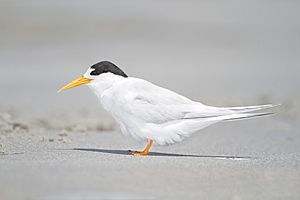Fairy tern facts for kids
- The name fairy tern can also refer to the white tern (Gygis alba)
Quick facts for kids Fairy tern |
|
|---|---|
 |
|
| Conservation status | |
| Scientific classification | |
| Genus: |
Sternula
|
| Species: |
nereis
|
| Subspecies | |
|
Sternula nereis davisae |
|
| Synonyms | |
|
Sterna nereis |
|
The fairy tern (Sternula nereis) is a small and beautiful seabird. It lives in the southwestern Pacific. This tiny tern is known for its graceful flight. It is currently listed as "Vulnerable" by a group called the IUCN. This means its population needs help to grow. The New Zealand subspecies is even more at risk. It is considered "Critically Endangered".
There are three types, or subspecies, of the fairy tern:
- The Australian fairy tern (Sternula nereis nereis) was named by John Gould in 1843. It lives and breeds in Australia.
- The New Caledonian fairy tern (Sternula nereis exsul) was named by Gregory Mathews in 1912. It breeds in New Caledonia.
- The New Zealand fairy tern (Sternula nereis davisae) was named by Mathews and Tom Iredale in 1913. It breeds in northern New Zealand.
Contents
What Does a Fairy Tern Look Like?
The fairy tern is a small bird. It has a white body and light bluish-grey wings. A small black patch goes no further than its eye. It does not reach its beak.
When they are breeding, their beak and legs are yellowish-orange. During the rest of the year, the black crown feathers are mostly replaced by white ones. The beak also becomes black at the tip and base. Both male and female fairy terns look alike. Young birds look similar to adults when they are not breeding. A fairy tern is about 25 cm (10 in) long.
How Do Fairy Terns Behave?
Fairy terns mostly eat fish. They catch fish by hovering over the sea. Then they plunge headfirst into the water to grab their prey. They usually stay close to the shore. You might see them where bigger fish are hunting schools of small fish. They also eat crustaceans (like crabs) and molluscs (like snails). Sometimes, they eat a bit of plant material too.
They breed in the spring. They form colonies on calm beaches. These can be on the mainland or on islands. Their nest is a simple scrape in the sand. It is just above the high-water mark. They usually lay one or two eggs. Both parents take turns sitting on the eggs. They also share the job of caring for the chicks. Sometimes, they even look after their young after they learn to fly.
Why Are Fairy Terns Important?
The fairy tern's numbers have been going down quickly. Because of this, its status was changed to "Vulnerable" in 2008. This means it needs protection. The New Zealand fairy tern has been very close to extinction for many years.
The New Zealand fairy tern has several breeding areas. Most of these are in the upper-north part of the North Island. In 2011, there were only about 42 known birds. Thanks to a breeding program by the New Zealand Department of Conservation, their numbers are slowly growing. In 2018, the population was estimated at 43 birds. These programs help protect these special birds for the future.
- Douglas Adams & Mark Carwardine, Last Chance to See (Ballantine Books, 1992, ISBN: 0-345-37198-4)
See also
 In Spanish: Charrancito australiano para niños
In Spanish: Charrancito australiano para niños


